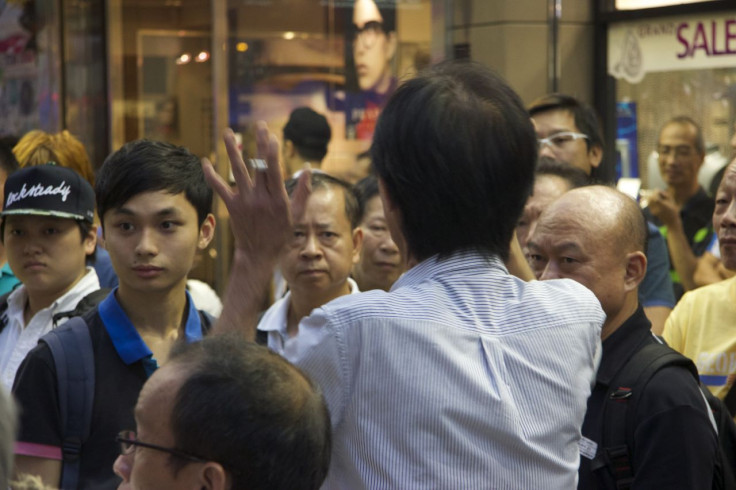Hong Kong Protest 2014: Pro-Police Demonstrators Get Removed - By Police

HONG KONG -- Members of a pro-government group who support the police and oppose Occupy Central demonstrators attempted to enter the main protest area outside government headquarters in Admiralty on Tuesday but were removed by the police themselves. The police have rarely resorted to physical action in the past week, whether against protesters or their opponents.
The group was confronted as it left a nearby office building by hundreds of protesters who jeered and shouted at them. In a confined area between two buildings, the small group was hugely outnumbered, and Leticia Lee, the group's organizer, addressed protesters through a bullhorn. The group's attempt to access the protest site was eventually halted by police officers who cut through the crowd and led them away, to the cheers of the Occupy protesters. Lee could be heard saying: “This is violence. This is not real democracy. You are bullying a woman. I will come back.”
The assembled crowd shouted that the group was “paid to demonstrate,” reflecting a view widely held among Occupy protesters and students that both peaceful anti-Occupy activists and those who violently attacked protesters at two sites last week were agents of the authorities.
But the police's "hands-off" approach to Occupy protesters, which has been in evidence since the authorities were widely condemned for using tear gas and pepper spray last week, appears to be designed to encourage the protests to fizzle out, by denying them the oxygen of outrage against heavy-handed police tactics. Many protesters told International Business Times on Tuesday that such tactics were their primary motivation for taking part.
“What has kept us going was the police brutality, the sheer lack of respect,” Gary Yeung, 25, an organizer and spokesman at one of the main supply depots for protesters in Admiralty, said.
Other anti-Occupy activists, however, were more successful in their attempts to confront protesters. The main stage in the middle of the protest camp, which has seen speeches from student leaders and other activists every evening since the protests began, was briefly commandeered by an elderly man who urged protesters to accept a slower path to full democracy. He was asked to leave, and he did so after a brief exchange with organizers.
Such exchanges are commonplace at protest sites throughout the city. Earlier Tuesday, opponents of the occupation had to be separated from protesters by police, and passionate but nonviolent exchanges were commonplace.
Anti-Occupy activists have adopted a blue ribbon as their symbol, in contrast to Occupy's yellow ribbon. The movement encompasses a wide range of groups, from Lee's mostly middle-aged, "pro-police" group, to the masked men who physically attacked protesters on Friday.
While at least eight of the 19 people arrested over violence on Saturday had links to Hong Kong's organized crime groups, most members of the blue-ribbon groups appear to be conservative Hong Kongers, more concerned with economic than political development.
In the months before the protests began, business groups in the city had warned that "the social unrest and political instability created by Occupy Central will deter foreign companies from investing in Hong Kong, thereby creating an enormous ripple effect throughout the local economy [and] … reducing employment opportunities.”
“We know deep down that our attempt is probably futile, because if you look at the history of China, they never give up, they never compromise; that's the source of their power. Even if we get a slight compromise, we'd consider ourselves very lucky,” protest organizer Yeung said.
© Copyright IBTimes 2024. All rights reserved.






















